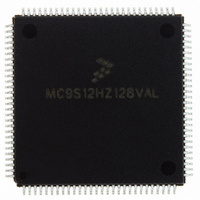MC9S12HZ128VAL Freescale Semiconductor, MC9S12HZ128VAL Datasheet - Page 196

MC9S12HZ128VAL
Manufacturer Part Number
MC9S12HZ128VAL
Description
IC MCU 16BIT 2K FLASH 112-LQFP
Manufacturer
Freescale Semiconductor
Series
HCS12r
Datasheet
1.MC9S12HZ128CAL.pdf
(692 pages)
Specifications of MC9S12HZ128VAL
Core Processor
HCS12
Core Size
16-Bit
Speed
25MHz
Connectivity
CAN, EBI/EMI, I²C, SCI, SPI
Peripherals
LCD, Motor control PWM, POR, PWM, WDT
Number Of I /o
85
Program Memory Size
128KB (128K x 8)
Program Memory Type
FLASH
Eeprom Size
2K x 8
Ram Size
6K x 8
Voltage - Supply (vcc/vdd)
2.35 V ~ 5.5 V
Data Converters
A/D 16x10b
Oscillator Type
Internal
Operating Temperature
-40°C ~ 105°C
Package / Case
112-LQFP
Processor Series
S12H
Core
HCS12
Data Bus Width
16 bit
Data Ram Size
6 KB
Interface Type
I2C/SCI/SPI
Maximum Clock Frequency
50 MHz
Number Of Programmable I/os
85
Number Of Timers
8
Maximum Operating Temperature
+ 105 C
Mounting Style
SMD/SMT
3rd Party Development Tools
EWHCS12
Minimum Operating Temperature
- 40 C
On-chip Adc
16-ch x 10-bit
Lead Free Status / RoHS Status
Lead free / RoHS Compliant
Available stocks
Company
Part Number
Manufacturer
Quantity
Price
Company:
Part Number:
MC9S12HZ128VAL
Manufacturer:
Freescale Semiconductor
Quantity:
10 000
Part Number:
MC9S12HZ128VAL
Manufacturer:
FREESCALE
Quantity:
20 000
- Current page: 196 of 692
- Download datasheet (4Mb)
Chapter 5 Clocks and Reset Generator (CRGV4)
If the MCU gets an external reset during pseudo-stop mode active, the CRG asynchronously restores all
configuration bits in the register space to its default settings and starts the reset generator. After completing
the reset sequence processing begins by fetching the normal reset vector. Pseudo-stop mode is exited and
the MCU is in run mode again.
If the clock monitor is enabled (CME = 1) the MCU is able to leave pseudo-stop mode when loss of
oscillator/external clock is detected by a clock monitor fail. If the SCME bit is not asserted the CRG
generates a clock monitor fail reset (CMRESET). The CRG’s behavior for CMRESET is the same
compared to external reset, but another reset vector is fetched after completion of the reset sequence. If the
SCME bit is asserted the CRG generates a SCM interrupt if enabled (SCMIE=1). After generating the
interrupt the CRG enters self-clock mode and starts the clock quality checker (see
Section 5.4.4, “Clock
Quality
Checker”). Then the MCU continues with normal operation. If the SCM interrupt is blocked by
SCMIE = 0, the SCMIF flag will be asserted but the CRG will not wake-up from pseudo-stop mode.
If any other interrupt source (e.g. RTI) triggers exit from pseudo-stop mode the MCU immediately
continues with normal operation. Because the PLL has been powered-down during stop mode the PLLSEL
bit is cleared and the MCU runs on OSCCLK after leaving stop mode. The software must set the PLLSEL
bit again, in order to switch system and core clocks to the PLLCLK.
Table 5-12
summarizes the outcome of a clock loss while in pseudo-stop mode.
MC9S12HZ256 Data Sheet, Rev. 2.05
196
Freescale Semiconductor
Related parts for MC9S12HZ128VAL
Image
Part Number
Description
Manufacturer
Datasheet
Request
R
Part Number:
Description:
Manufacturer:
Freescale Semiconductor, Inc
Datasheet:
Part Number:
Description:
Manufacturer:
Freescale Semiconductor, Inc
Datasheet:
Part Number:
Description:
Manufacturer:
Freescale Semiconductor, Inc
Datasheet:
Part Number:
Description:
Manufacturer:
Freescale Semiconductor, Inc
Datasheet:
Part Number:
Description:
Manufacturer:
Freescale Semiconductor, Inc
Datasheet:
Part Number:
Description:
Manufacturer:
Freescale Semiconductor, Inc
Datasheet:
Part Number:
Description:
Manufacturer:
Freescale Semiconductor, Inc
Datasheet:
Part Number:
Description:
Manufacturer:
Freescale Semiconductor, Inc
Datasheet:
Part Number:
Description:
Manufacturer:
Freescale Semiconductor, Inc
Datasheet:
Part Number:
Description:
Manufacturer:
Freescale Semiconductor, Inc
Datasheet:
Part Number:
Description:
Manufacturer:
Freescale Semiconductor, Inc
Datasheet:
Part Number:
Description:
Manufacturer:
Freescale Semiconductor, Inc
Datasheet:
Part Number:
Description:
Manufacturer:
Freescale Semiconductor, Inc
Datasheet:
Part Number:
Description:
Manufacturer:
Freescale Semiconductor, Inc
Datasheet:
Part Number:
Description:
Manufacturer:
Freescale Semiconductor, Inc
Datasheet:











